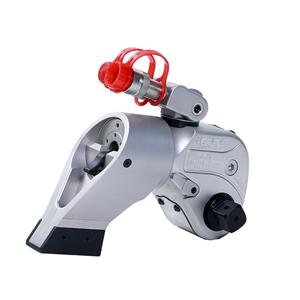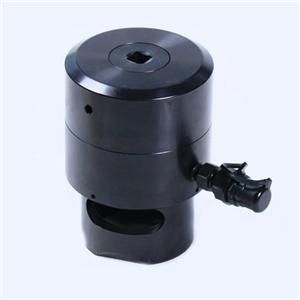How To Calculate The Torque Of A Bolt?
In many cases, the calculation of bolt torque is a very important issue, which can help us choose more suitable hydraulic tools for work. Therefore, I will show you how to calculate the bolt torque.
Now, let's start.
Calculation formula of ordinary bolt torque:
T = KFd(N,mm)
K, tightening torque coefficient, a reference value can be roughly selected according to the surface state. For general machined surfaces, if there is lubrication, K can be 0.13-0.15; if there is no lubrication, K can be 0.18~0.21;
D, refers to the nominal diameter of the thread
F, is the pre-tightening force, carbon steel bolt F=(0.6~0.7)σA; alloy steel bolt F=(0.5~0.6)σA; where σ is the yield point of the bolt material; A=π/16(d2+d3 )2, d2 is the middle longitude of the thread, d3=d1-H/6; d1 is the minor diameter, H is the original triangular height of the thread; the H value can be calculated according to different threads, which is about 0.87 times the pitch P.
T, bolt torque.
Put the values of different parameters into the formula to get the theoretical torque value of the bolt.
You can check our bolt maximum torque table to help you save time and reduce the trouble of calculation.
Calculation formula of high-strength bolts:
T = KPd
K is the torque coefficient, you can refer to the manufacturer's test report and on-site retest report,
P is the standard value of the construction pretension value.
D is the bolt diameter.
For example
Torque calculation of high-strength bolts
High-strength bolts exert pre-tension and transmit external force by friction. Ordinary bolt connections rely on the shear resistance of the bolt rod and the pressure of the inner wall of the hole to transmit the shear force. The pre-tension force generated when the nut is tightened is very small, and its effect can be ignored. In addition to the high material strength of the high-strength bolt, it also applies to the bolt. A large pretension force produces an extrusion force between the connecting members, thereby causing a large friction force perpendicular to the screw direction. Moreover, the pretension force, the anti-slip coefficient and the type of steel directly affect the bearing capacity of the high-strength bolt.
According to the characteristics of the force, it is divided into pressure type and friction type, and the calculation methods of the two are different. The minimum specification of high-strength bolts is M12, and M16~M30 are commonly used. The performance of oversized bolts is unstable and should be used with caution in the design.
High-strength bolts refer to bolts with relatively strong grade hardness performance, also called high-strength bolts. Generally refers to 8.8 or above, such as 10.9 grade bolts and 12.9 grade bolts, which have strong hardness and torsion resistance.
In the labeling method, the number before the decimal point of the performance level represents 1% of the nominal tensile strength σb of the material. The number after the decimal point represents 10 times the ratio of the yield strength σs of the material to the nominal tensile strength. The nominal tensile strength of 8.8 performance grade of M20 bolts is σb=800MPa, and the minimum tensile strength σb=830MPa. Nominal yield strength σs=640, minimum yield strength σs=660
There is another explanation. The number before the decimal point indicates the tensile strength after heat treatment. The number after the decimal point represents the yield ratio, that is, the ratio of the measured value of the yield strength to the measured value of the ultimate tensile strength. Grade 8.8 means that the tensile strength of the bolt rod is not less than 800 MPa, and the yield ratio is 0.8. Grade 10.9 means that the tensile strength of the bolt rod is not less than 1000 MPa, and the yield ratio is 0.9.
Calculation of the length of high-strength bolts
High-strength bolt connection must strictly control the length of the bolt. The length of the torsion shear type high-strength bolt is the length from the lower supporting surface of the screw head to the cut of the screw tail; for the high-strength hexagon head bolt, the thickness of a washer should be added.
The general formula for calculating the length of high-strength bolts is as follows:
L=L''+△L
Where △L=M+NS+3P
In the formula, L—the length of the high-strength bolt;
L''—total thickness of connecting board;
△L—additional length, that is, the lengthened value of tightening length;
M—Nominal thickness of high-strength nut;
N—Number of washers, 1 for torsion shear type high-strength bolts, 2 for high-strength hexagon head bolts
S—Nominal thickness of high-strength washer
P-the pitch of the thread.
The tightening length extension value of high-strength bolts = bolt length-plate thickness. Generally, the length of the connecting plate thickness plus L is used, and the value is an integral multiple of 5mm.
Before high-strength bolt construction, the torque coefficient of the high-strength bolt connection pair should be re-examined according to the factory batch. 8 sets of each batch should be re-examined. The average value of the torque coefficient of the 8 sets should be within the range of 0.110~0.150, and the standard deviation should be less than Or equal to 0.010. After the test, the high-strength bolts should be installed in a short time.
The construction torque of high-strength bolts is calculated and determined by the following formula:
Tc=1.05k•Pc•d
Tc—construction torque (N•m);
k—The average value of the torque coefficient of the high-strength bolt connection pair;
Pc—Pre-tension for construction of high-strength bolts (kN), see Table 1;
d—High-strength bolt screw diameter (mm);
The torque wrench used in the construction of high-strength bolts must be calibrated before use, and the torque error shall not be greater than ±5%, and it shall be used only after it is qualified. For the torque wrench used for calibration, the torque error shall not exceed ±3%.
What is the maximum tensile force of a grade 8.8 bolt?
Calculation method
The maximum stress value before the steel breaks under tension is called the strength limit or tensile strength
F = σs * A
F is the tensile force (allowable load)
σs is the tensile strength of the material
A is the effective area, and the effective area is the cross-sectional area at the smallest diameter on the effective length of the bolt.
The effective diameter of M20 is Φ17, the effective cross-sectional area is 227 square millimeters, and the minimum tensile strength of M20 of class 8.8 is σb=830MPa.
F = 830*227=188.41KN
Therefore, the minimum tensile strength of M20 bolt 8.8 performance grade is 188.41KN.
Pre-tightening torque Mt = K*P0*d*0.001N.m
K: Tightening force coefficient
D: Nominal diameter of thread
P0: preload
As: Π*ds*ds/4 (ds: the calculated diameter of the dangerous section of the threaded part)
ds: (d2+d3)/2
d3: d1-H/6 (H: nominal working height of thread)
σ0=(0.5~0.7)σs
σs: yield limit of bolt material N/mm2
K: refer to the table
Source: https://torcstark.com/how-to-calculate-the-torque-of-a-bolt/




